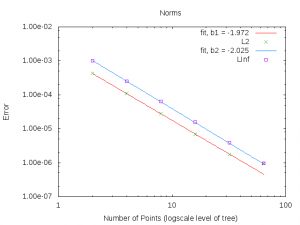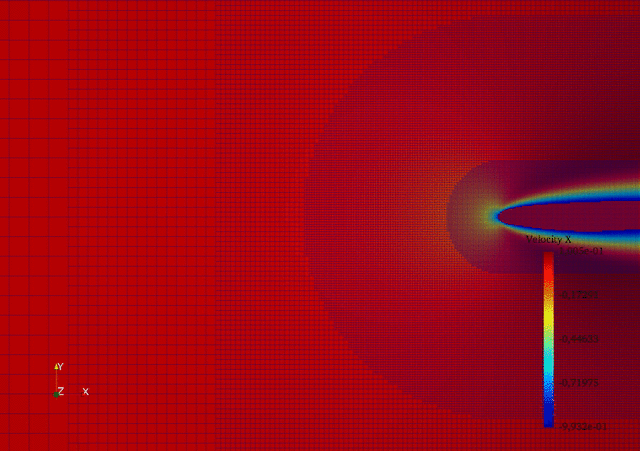3D incompressible Navier-Stokes solver
A 3D incompressible Navier-Stokes solver is being developed in the frame of a PhD Thesis in partnership with VALOREM. This code is natively parallel and and octree discretisations are considered in order to locally refine the mesh in the regions characterised by the most interesting turbulent structures.
-
Schemes
The numerical solution of the Navier-Stokes equations on the non-conforming meshes obtained by the octree discretisation is quite involved when finite differences schemes are used. For this reason, the solver is based on a semi-lagrangian finite volume method. A fractional-step method is used with prediction, projection (Poisson-like equations) and correction steps. The semi-lagrangian scheme simplifies significantly the management of hanging-nodes grids and so it makes it possible to efficiently exploit strongly refined octree meshes. The order of convergence in space of the Poisson solver is 2 as can be seen in figure below. Moreover, a penalization approach is used to deal with obstacles in the flow.
-
Adaptive Mesh Refinement
A grid adaptation process has been developed. It allows for exemple to deal with moving bodies and to focus on interesting areas in the computational domain. With user defined criteria, the grid is indeed automatically refined or coarsened. So, this code allows a fast meshing of the computational domain thanks to the penalization approach. An interesting compromise between computational time and accuracy is also reached thanks to the adaptive mesh refinement process.
-
Applications
Memphis team of INRIA and VALOREM are both involved in the european project AeroGust (Aeroelastic gust modelling). One of the task aims to investigate the behaviour of wind turbine blades submitted to gust using incompressible flow model and Octree grids.
The next steps of work will be to validate the 3D code which is currently under development. The new CFD code on octree grids will also be coupled with a structural beam model so that aeroelastic effects of blades could be studied.
Industrial applications of this work can be a better evaluation of wind turbine performance. For exemple, estimation of potential production increase thanks to aerodynamic devices or new blades could be computed. Or, when developing a future wind farm, the tool could allow to evaluate accurately the wind production in an area.






